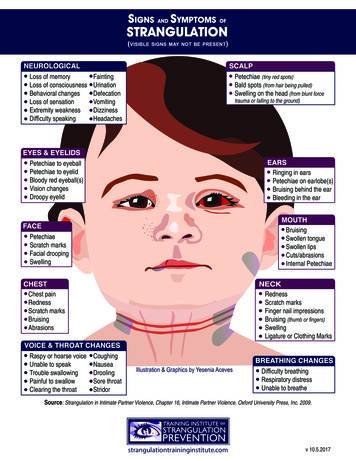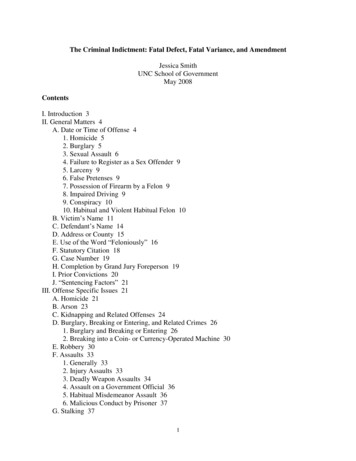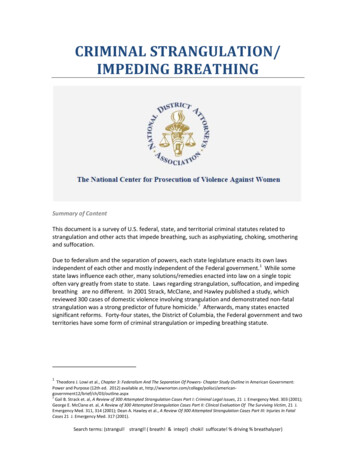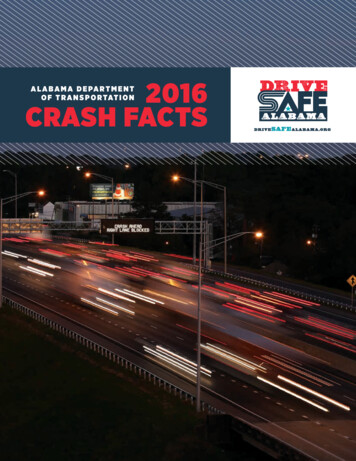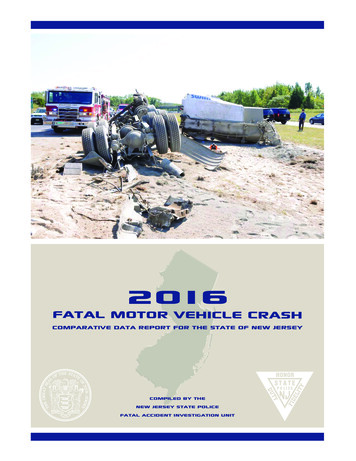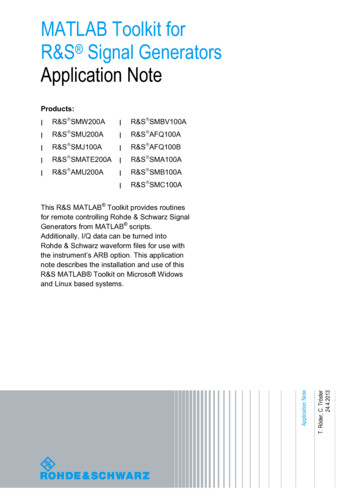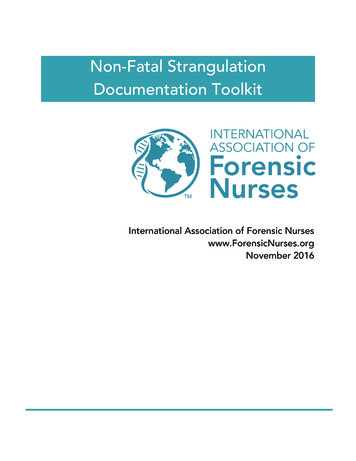
Transcription
Non-Fatal StrangulationDocumentation ToolkitInternational Association of Forensic Nurseswww.ForensicNurses.orgNovember 2016
TABLE OF CONTENTSPrefaceiStrangulation Task Force Members1Purpose3Section I – Non-Fatal StrangulationStrangulation Assessment, Documentation, and Evidence Collection Guidelines4Section II – Non-Fatal Strangulation Policy and ProcedureExample Policy and Procedure7Section III – Clinical Evaluation and DocumentationNon-Fatal Strangulation Clinical Evaluation9Non-Fatal Strangulation Descriptors for Examiners11Non-Fatal Strangulation Documentation Form14Section IV – Discharge InstructionsExample Strangulation Discharge InstructionsAdditional prehensive Bibliography25
PREFACEIn 1992, The International Association of Forensic Nurses (IAFN) was created by a group of nurses thatrecognized violence as a healthcare problem. Over the past two and a half decades much progress has beenmade as it relates to the care of our specialized patient population. Through this progress, knowledge hasbeen gained and practice guidelines continue to evolve with the goal of continuous provision of safe andeffective patient care.In early 2015, the IAFN, the Board of Directors and a group of members recognized strangulation as ahealthcare concern that needed practice guidance throughout the organization, and as a result, theStrangulation Task Force was created and was proven to be a group of hard working, dedicated individualsthat are truly experts on strangulation. This group was tasked with establishing standards for theorganization and developed what would be utilized as a toolkit for best practice provision.The Strangulation Toolkit provides the forensic nurse with detailed guidance on assessment techniques,documentation, and evidence collection for this patient population. This toolkit also provides documents suchas discharge instructions and sample policies that can be adjusted to best suit your institution and yourforensic practice.As a toolkit, it should be mentioned that the IAFN does not endorse any changes to these documents.Limitations of this toolkit include the lack of research available to guide our practice, making the need foradditional research related to the management of the patient that has been strangled a high priority. Also, itshould be mentioned that each clinician must refer to their own individual state practice acts whenconsidering the implementation of any parts of this toolkit.The Strangulation Toolkit is the first of its kind to be endorsed by the IAFN and will be a useful guide toimproving and standardizing the care of patients that have been strangled. As a group, we will continue tostrive to move our profession forward and improve practice internationally and this toolkit proves to keep uson this path.International Association of Forensic Nurses www.ForensicNurses.orgi
STRANGULATION TASK FORCE MEMBERSBarbra Bachmeier, MSN, JD, NP-C (Chair)Nurse Practitioner/Forensic Nurse ExaminerIU Health – Methodist Emergency Medicine and Trauma CenterIndianapolis, INKhara Breeden, DNP, MS, RN, SANE-A, SANE-P, CA/CP-SANEMissouri City, TXTeresa J. Devitt-Lynch, MSN, RN-BC, SANE-A, CFN, CMI-I, DACFEIUnited States NavyNavy Medicine Education and Training CommandJoint Base-San Antonio, Fort Sam Houston, TXRuth Downing, MSN, RN, CNP, SANE-APresident and FounderForensic Healthcare ConsultingDelaware, OHDiana Faugno, MSN, RN, CPN, SANE-A, SANE-P, FAAFS, DF-IAFNEisenhower Medical CenterRancho Mirage, CASarah Hines, BSN, RN, CFN, SANE-AEskenazi Health Center of HopeIndianapolis, INAnnie Lewis-O'Connor, PhD, MPH, NP-BC, FAANSenior Nurse Scientist Founder and DirectorC.A.R.E. ClinicBrigham and Women's HospitalBoston, MAJenifer Markowitz, ND, RN, WHNP-BC, SANE-A, DF-IAFNAlexandria, VAJennifer Pierce-Weeks, RN, SANE-A, SANE-PEducation DirectorInternational Association of Forensic NursesElkridge, MDLinda Reimer, BScN, RN, SANE-A, TITC-CTDomestic Abuse and Sexual Assault Care Centre of York RegionMackenzie Richmond Hill HospitalRichmond Hill, ONHolly Renz, RN, SANE-A, SANE-PProgram DirectorMadison County SATC of Community HospitalAnderson, INInternational Association of Forensic Nurses www.ForensicNurses.org1
Suzanne Rotolo, PhD, MSN, RN, SANE-A, SANE-P, CFN, FACFEIDr. Rotolo ConsultingLeesburg, VABill Smock, MS, MDPolice SurgeonLouisville Metro Police DepartmentClinical Professor of Emergency MedicineUniversity of Louisville School of MedicineLouisville, KYGael Strack, Esq.CEO and Co-FounderTraining Institute on Strangulation Prevention, a program of Alliance for HOPE InternationalSan Diego, CASally Sturgeon DNP, RN, SANE-A, AFN-BCForensic Nurse ExaminerInstitute of Clinical Forensic Medicine and NursingLouisville, KentuckyMelissa Vesperman, BSN, RN, SANE-AForensic Nurse CoordinatorSt. Croix Valley SARTRiver Falls, WISarah Wells, BSN, RN, SANE-A, SANE-PBon Secours Richmond Health SystemBon Secours Richmond Forensic Nursing ServicesRichmond, VAInternational Association of Forensic Nurses www.ForensicNurses.org2
PURPOSEThe Non-Fatal Strangulation Documentation Toolkit was developed by consensus to assist clinicians inmultiple settings and various disciplines with the evaluation of non-fatal strangulation.International Association of Forensic Nurses www.ForensicNurses.org3
STRANGULATION ASSESSMENT, DOCUMENTATION,AND EVIDENCE COLLECTION GUIDELINESEquipment Needed Camera Measuring tape Evidence collection kit (swabs, sterile saline or water, envelopes, paper bags,evidence tape, etc.) ABFO No. 2 ruler Speculum Mannequin or Styrofoam head (optional) GlovesDefinitionStrangulation is a form of asphyxia produced by a constant application of pressure to the neck. The threeforms of strangulation are: hanging, ligature, and manual. Hanging occurs when a person is suspended with aligature around his or her neck, which constricts due to the gravitational pull of the person’s own bodyweight. Ligature strangulation occurs when the pressure applied around the neck is with a ligature only.Manual strangulation occurs when pressure is applied to the neck with hands, arms, or legs. (Ernoehazy,2016; Funk & Schuppel, 2003; Line, Stanley, & Choi, 1985; Taliaferro, Hawley, McClane, & Strack, 2009;Wilbur et al., 2001).Anatomy/PathophysiologyPressure around the neck can result in the closure of blood vessels and/or air passages. Injury and deathfrom strangulation occur from one or more mechanisms. The first mechanism is venous obstruction, wherebyocclusion of the jugular veins results in congestion of the blood vessels and increased venous and intracranialpressure. The second mechanism is carotid artery obstruction, which stops blood flow and impedes oxygendelivery to the brain. The third mechanism is pressure on the carotid sinus that can cause acute bradycardiaand/or cardiac arrest. Strangulation can result in injuries to the soft tissues of the neck, esophagus, larynx,trachea, cervical spine, and the laryngeal and facial nerves. (Hawley, McClane, & Strack, 2001; Shields, Corey,Weakley-Jones, & Stewart, 2010; Smith, Mills, & Taliaferro, 2001; Taliaferro, Hawley, McClane, & Strack,2009). 2016 CFNEI. All rights reserved. May not bereproduced, published, distributed, displayed,performed, copied, or stored for public or privateuse without the written permission of CFNEI.International Association of Forensic Nurses www.ForensicNurses.org4
History/Patient Description of the Strangulation EventDescribe what happened, using the patient’s own words. Place quotation marks around the patient’scomments. Also, describe the patient’s appearance, behavior, speech, eye contact, and affect/demeanor usingterms such as “slumped,” “weeping,” “averting eye contact,” “stammering,” “somber,” “agitated,” etc. Includethe assailant’s name, date of birth, and his or her relationship to the patient. Attach additional pages, ifneeded. Below are specific questions to ask each patient who reports strangulation. (As needed, rewordquestions to the appropriate developmental level of the patient.) Describe and demonstrate on the head model how you were strangled. One hand? Two hands? Arm?Leg? Other object(s)? How many times were you strangled?/Over what period of time? Were you shaken while you were being strangled? Was your head pounded on the ground or wall while you were being strangled? Did your feet leave the ground while you were being strangled? How long did the strangulation(s) last? On a scale of 0–10, how much pressure was applied to your neck during the strangulation(s)? What did you think was going to happen? What did the assailant say to you before, during, and after you were strangled? What made the person stop strangling you? Were you suffocated (defined as smothered)? (Suffocation refers to obstruction of the airway at thenose or mouth.) Did you have any difficulty breathing or an inability to breathe? Did you or do you currently have a cough? Did you or do you currently have trouble swallowing? Did you have a hoarse, raspy, or complete loss of voice? Did you or do you currently have any changes in your vision? (seeing spots, tunnel vision, blurryvision, everything went black, etc.) Did you or do you currently have any changes in your hearing? (roaring, ringing, etc.) Did you become dizzy or lightheaded? Did you lose consciousness? (passed out, blacked out, etc.) Did you experience any mental status changes? (restlessness, combativeness, amnesia, psychosis,etc.) Did you vomit as a result of being strangled? Did you lose control of urine or stool while you were being strangled? Were you sexually assaulted? Were you slapped, punched, kicked, or bitten anywhere on your body? Have you been strangled prior to this event?/How many times? Did you or do you have a headache? Did you bite your tongue or the inside of your mouth? If pregnant, are you having any abdominal cramping, vaginal discharge, or bleeding? Were you sexually assaulted during the event?(Funk & Schuppel, 2003; Gwinn & Strack, 2013; Strack & McClane, 1999).Documentation of Physical Findings/Description of InjuriesExamine the head, face, neck, and chest completely, using 360 degrees. Closely examine the sclera,conjunctiva, lips, oral cavity, palate, ears, and scalp. Observe for areas of erythema, abrasion, contusion,swelling, laceration, incised wound(s), fracture, bite mark(s), burn(s), or tenderness. Record each injury,including patient statements about the injury (e.g. “he grabbed my neck; that wasn’t there before he did that”)by drawing a diagram. Label each injury drawn on the diagram by using the consecutive alphabetical ornumerical systems (A, B, C or 1, 2, 3, etc.) to describe each injury separately. Attach additional pages ifneeded. Document the location, shape, color, and size of all injuries, using centimeters as the unit of measure.Note length, width, and depth for each injury (if possible). Also, measure the neck with a measuring tape toestablish a baseline for follow-up measurements (to determine whether neck swelling is present). Include thefollowing in the patient’s assessment: Voice changes: Dysphonia (defined as hoarseness) or aphonia (defined as severe or complete loss ofvoice)International Association of Forensic Nurses www.ForensicNurses.org5
Swallowing changes and tongue swelling: Dysphagia (defined as difficulty swallowing) orodynophagia (defined as painful swallowing) Breathing changes: Dyspnea (defined as difficulty breathing) Visible injuries on the neck and mastoid: Ligature marks/edema/abrasions (scratches andscrapes)/erythema/contusions Petechiae: Eyelids/peri-orbital region/face/scalp/neck/ears/soft palate/under tongue Subconjunctival/Scleral hemorrhage/Scleral edema (eyes) Neurological findings: Ptosis/facial droop/unilateral weakness/loss of sensation/paralysis/seizure Neck swelling: Measurement (in centimeters) for size (mark neck with a Sharpie pen for accuratefollow-up measurement) Miscarriage/Pregnancy - FHT/LMP Lung injuries: Aspiration pneumonia/pulmonary edema Other symptoms: Acid reflux, etc. Pain, swelling, erythema, contusion, abrasion, petechiae, bite marks, knife wounds, or gunshotwounds on any other area of the body (i.e., chest, back, upper extremities, lower extremities)(Christe et al., 2009; Faugno, Waszak, Strack, Brooks, & Gwinn, 2013; Funk & Schuppel, 2003; Gwinn & Strack,2013; Hawley, McClane, & Strack, 2001; Strack & McClane, 1999; Taliaferro, Hawley, McClane, & Strack,2009). PhotographsUse your facility/community protocol. If no protocol is available, use the guidelines listed below. Take full-body distant and mid-distance photographs. Take multiple photographs of the front, sides,and back of the face, neck, upper chest, and shoulders. Carefully assess and photograph the eyes and mouth. Take multiple photographs of both eyes of thepatient looking up, down, to the left, to the right, and straight ahead. To visualize and photograph theconjunctival sac, gently pull down on the lower lid with a gloved hand. If no ocular trauma is presentand if the patient is able to tolerate, flip the upper eyelids up on each eye to visualize and photograph. With the patient’s mouth open, depress the tongue with appropriate assistive devices to light theinternal structures. Take photographs of the upper and lower lips, frenula, under the tongue, the softpalate, uvula, and oropharynx. To completely visualize and photograph the oral structures, rotate thecamera so the flash is in various positions, including the upright position, left, right, and upside down. Perform a complete head-to-toe assessment of the patient, and photograph and document all injuries.Take close-up photographs of all injuries with and without a measurement ruler in place. Ensure thatthe plane of the object being photographed is at 90 degrees. (Optional) Photograph the patient’s demonstration on the strangulation model of how he or she wasstrangled. Take follow-up photographs of all visible injuries within 72 hours post-assault (based upon patientneeds, availability, etc.).(Funk & Schuppel, 2003; Paluch, 2013; Strack & McClane, 1999).Collection of EvidenceUse your facility/community protocol. Consult your local forensic laboratory for recommendations. If noprotocol is available, use the guidelines listed below. Collect dried and moist secretions (i.e., blood stains, saliva, etc.) from the face, head, neck, and mouth.Use two or four (as indicated by protocol/recommendation) sterile cotton swabs for each specimen.Swab moist secretions with dry swabs. Swab dry secretions with swabs moistened with sterile salineor sterile water. Air dry the swabs before packaging in an envelope or a swab box. Make control swabs by moistening swabs with the sterile saline or sterile water used (as indicated byprotocol/recommendation). If collecting control swabs, label, air dry, and package separately fromthe evidence samples. Collect fingernail swabs, if indicated per history. Place swabs from each hand into a separate, labeledenvelope. Label each envelope or swab box with the contents, patient name, collector name, the date, and timeof collection. Seal the envelope with tape, and then initial. Document location and the potentialbiological specimen identified.(Gwinn & Strack, 2013; Hawley, McClane, & Strack, 2001).International Association of Forensic Nurses www.ForensicNurses.org6
EXAMPLE POLICY AND PROCEDUREPolicy Name: Standard of Practice in Non-Fatal Strangulation Cases1.PurposeTo have a policy that identifies and communicates evidenced-based best practice/standard ofpractice based upon the assessment of the patient, the caregiver/guardian/patient’s consent, andmedical status in non-fatal strangulation cases.2.PolicyEach patient will be assessed for the purpose of medical diagnoses and treatment. This will includethe physical assessment, collection of potential biological and trace evidence to identify any forensicfindings, and documentation of objective findings and subjective complaints (Faugno, Waszak, Strack,Brooks, & Gwinn, 2013).Any procedure that is completed by another professional (i.e., social work, advocate) should bedocumented as such.Follow institutional/local guidelines, policies, laws for the incapacitated patient or minor.3.Procedurea) Thorough head-to-toe physical assessment (genital examination to be conducted as indicated)b) Completion of danger assessment/lethality assessment (Campbell, 2004; Campbell, Webster, &Glass, 2009)c) Completion of strangulation documentation to include:a. Written documentation formb. Body mapping of injuriesc. Photo-documentationd. Mannequin demonstration (optional)d) Neck circumference measuremente) Use of alternate light source (ALS)/ultraviolet (UV) light (as indicated or available) foridentification of potential biological fluids and/or for enhancement of visual bruises (not to beused to identify bruises that cannot be seen) (Eldredge, Huggins, & Pugh, 2012)f) Potential evidence collection (as applicable or if indicated)g) Assist patient with acquiring the necessary resources to file for victim of violent crimefund/compensation per local jurisdiction (if available)h) Assess for safety planning/resources dispositionFollow individual, local, mandated reporter for adult/pediatric population with referrals asneeded to adult protection services (APS) and/or child protective services (CPS).i) If evaluation results indicate need, discuss possibility of observation or overnight admission.j) Discuss follow-up plan of care4.Follow-Up CareFollow up examinations within 72 hours post assault. In case of holidays/weekends: follow up with aphone call within 72 hours, with a scheduled appointment as soon as possible (Taliaferro, Hawley,McClane, & Strack, 2009).Follow-up appointment to consist of:a) Head-to-toe physical assessmentb) Strangulation documentation formc) Photography (of progression of bruising or identification of new bruises)d) Neck circumferencee) Use of ALS/UV light (as indicated or available) as indicated above in #3ef) Ongoing safety assessmentInternational Association of Forensic Nurses www.ForensicNurses.org7
g) Referrals to ear, nose, and throat (ENT) specialist, neurology, other providers, counseling perscope of practice5.Terms1. Strangulation: A form of asphyxia (lack of oxygen) characterized by closure of the blood vesselsand/or air passages of the neck as a result of external pressure on the neck (Iserson, 1984; Line,Stanley, & Choi, 1985).2. Standards of Practice. Authoritative statements that “[describe a competent level of nursing careas demonstrated by the nursing process” (ANA, 2010, p. 67).3. Danger assessment: An easy and effective method for forensic nurses and other communityprofessionals to identify those who are at the highest potential for being seriously injured orkilled (lethality) by their intimate partners so as to immediately connect these patients andclients to a domestic violence service provider in their area.4. ALS (alternate light source): A high-intensity light using differing wavelengths that may fluorescefluids/fibers and help enhance bruises that can be seen under white light.5. UV (ultraviolet) light: An electromagnetic radiation with a wavelength from 100 nm to 400 nm. Aportion of the light spectrum, which is not visible to the naked eye, that may help fluorescefluids/fibers.6. Mannequin head: An effective tool to aid the patient in demonstrating the act of strangulation.International Association of Forensic Nurses www.ForensicNurses.org8
NON-FATAL STRANGULATION CLINICAL EVALUATIONThe following content is recommended as components of the clinical evaluation.Medical History Primary care physician Allergies Medical/Surgical history Pregnancy - LMP, live births, miscarriages, abortions Prior hospitalizations Smoking/Alcohol/Drug use Medications, including supplements/herbsSocial History Employed Lives with Children (biological patient/suspect) Past history of sexual or physical abuse, domestic violenceReview of SystemsPhysical Examination Appearance Eye contact Speech Responsiveness to clinician Nonverbal/Oral expression Facial expression Body posture and/or muscular tension Behaviors and actions Appearance of clothing Subjective complaints Any pain/Bleeding before, during, or after event Pre-existing complains of pain, injury, or skin conditionsForensic Medical Photography - Digital and/or colposcope (with and without ruler/scale) Full body Close-up Face Head/Scalp Neck Chest Mouth Eyes Mannequin demonstration Other injuries (i.e., defensive)Danger AssessmentMedical Evaluation/Radiology Studies (as indicated by medical provider) Pulse oximetry Chest X-ray Soft tissue of the neck X-ray CT of the neck with and/or without contrast CT angiogram of carotid/vertebral arteries MRI of the neckInternational Association of Forensic Nurses www.ForensicNurses.org9
MRA of the neckMRI/MRA of the brainInternational Association of Forensic Nurses www.ForensicNurses.org10
NON-FATAL STRANGULATION DESCRIPTORSFOR EXAMINERSDonna A. Gaffney, DNSc, RN, FAANBehaviors, Mannerisms, Speech, and Eye ContactDo not use language that could be construed as evaluative or can be interpreted as a value statement, orwords that assign a subjective or emotional experience to the survivor. Instead, use words that accuratelydescribe outward appearance, visible behavior, speech, and eye contact. These are words that conveythe emotional state of the survivor without specifically labeling it as such.Quantifying and Qualifying Behaviors (time, intensity, manner) When quantifying time, indicate the number of times a behavior was observed or the length of timeit was observed (i.e., cried for 20 minutes) When qualifying time, name the event that coincided or preceded the behavior ( i.e., sobbed as shetook off her clothes) When qualifying intensity, describe what was sensed (i.e., soft, loud, piercing, shrill, high-pitched,sharp, etc.) When qualifying manner, describe what was observed (i.e., measured, haltingly, abruptly,tentatively, etc.)Always use the patient’s statements and place in quotation marks. Do not paraphrase.Eye Contact orVisual dGapeStareLooks at (floor, ceiling, etc.)GoodWatchFixedOnly when addressedPoorAvoid (when)AvertCloses eyes (when, howlong)“Good” and “poor” meandifferent things todifferent erMurmurStutterShoutSlowScreamCries whilespeakingInternational Association of Forensic Nurses SuggestionsAvoidResponds in one or twoword answersResponds only when askedquestionsWhispers (differentiatefrom hoarseness)Hoarse (clarify if this isnormal or new)Hesitates (duration inseconds, minutes)www.ForensicNurses.org11
Responsiveness al/OralExpressionFacialExpressionsBody Postureand/orMuscularTensionBehaviorsand ActionsSuggestionsSuggestionsPause (beforestating . . .)Answers questions whenaskedUnresponsiveResponds only whenasked hed jawBiting lipsPursed lipsPuckerGrinding SlumpRestlessTrembleClutching(what)ShakeFeet pulledup as sits Holds front of shirttogether with both handsBlew noseClutchingclothesStunnedFlinchWipes at eyes with tissue AvoidShuddersClenches fistsCrosses arms in front ofbodyWrings handsDraws legs up, wraps armsaround knees (how andwhere)Pulling atsheetsInternational Association of Forensic s.org12
atedAvoidDepressedSadIn shockCoolComposedControlledFlat g AnxietyState that the client is anxious and then support with observable behaviors: wringing hands, tapping feet,sweating profusely, dilated pupils, or the client’s statement (e.g., “I feel nauseated,” “I have a knot in mystomach,” etc.).2001, Donna Gaffney AssociatesInternational Association of Forensic Nurses www.ForensicNurses.org13
NON-FATAL STRANGULATION DOCUMENTATION FORMPatient Name:Date:Medical Record Number:Time:Strangulation is a serious event that often occurs in the context of intimate partner violence (IPV). Manytimes strangulation presents NO VISIBLE INJURIES. It is important to ask about strangulation in all IPV cases,and document positive disclosure or any signs and symptoms.Strangulation Event HistoryHow long did the strangulation last?secondsminutescannot recallHow many times did strangulation occur?Why/how did the strangulation stop?What type of strangulation occurred? (Check all that apply) Hanging Ligature Manual OtherWhat was used to strangle the patient? Right hand Left hand Both hands Unknown Chokehold maneuver Other (describe)Was the patient smothered? No Yes (describe)Was the patient shaken during the incident? No Yes (describe)Was the patient’s head pounded against any object during the incident? No Yes (describe)Was the patient slapped, kicked, or bitten anywhere? No Yes (describe)Was the assailant wearing any jewelry on hands or wrists? Unknown No Yes (describe)Describe the neck pressure during strangulation on a 0–10 scale (0 no pressure and 10 crushing pressure):What is the measurement of the patient’s neck circumference?Was the patient sexually assaulted? No YesWhat was the patient thinking during the strangulation?What did the assailant say before, during, or after the strangulation?Describe mannequin demonstration (where applicable)International Association of Forensic Nurses www.ForensicNurses.org14
Signs/Symptoms of StrangulationThe following signs/symptoms should be asked about, assessed for and documented in writing, with bodymapping, and by photo-imaging (if applicable). Check ALL that apply.SignsFaceEyesNosePrior toStrangulation Red, flushed Petechiae Abrasions Cuts Lacerations Discoloration Swelling OtherDuringStrangulation Red, flushed Petechiae Abrasions Cuts Lacerations Discoloration Swelling OtherAfterStrangulation Red, flushed Petechiae Abrasions Cuts Lacerations Discoloration Swelling OtherAt time ofAssessment Red, flushed Petechiae Abrasions Cuts Lacerations Discoloration Swelling Other Discoloration Swelling Abrasions Petechiae:Conjunctiva Right LeftEyelids Upper right Lower right Upper left Lower left Discoloration Swelling Abrasions Petechiae:Conjunctiva Right LeftEyelids Upper right Lower right Upper left Lower left Discoloration Swelling Abrasions Petechiae:Conjunctiva Right LeftEyelids Upper right Lower right Upper left Lower left Discoloration Swelling Abrasions Petechiae:Conjunctiva Right LeftEyelids Upper right Lower right Upper left Lower left Subconjunctivalhemorrhage Right Left Subconjunctivalhemorrhage Right Left Subconjunctivalhemorrhage Right Left Subconjunctivalhemorrhage Right Left Ptosis Right Left Ptosis Right Left Ptosis Right Left Ptosis Right Left Vascularcongestion Right Left Vascularcongestion Right Left Vascularcongestion Right Left Vascularcongestion Right Left Other Bleeding Swelling Petechiae Discoloration Other Other Bleeding Swelling Petechiae Discoloration Other Other Bleeding Swelling Petechiae Discoloration Other Other Bleeding Swelling Petechiae Discoloration OtherInternational Association of Forensic Nurses www.ForensicNurses.org15
SignsMouthEarsHead/scalpNeck/underChinPrior toStrangulation Discoloration Swollen tongue Swollen lips Cut Lacerations Abrasions Petechiae Other Petechiae Right Left Bleeding fromear canal Right Left Discoloration Auditorychanges Other Petechiae onscalp Pulled hair Contusions Other Redness Scratch marks/abrasions Bruises Neck pain(Pain scale 0–10)Shoulders(Pain scale 0–10) Bruises Swelling Ligature marks Subcutaneousemphysema Other Redness Scratch marks/abrasions Bruises Neck pain(Pain scale 0–10) Bruises Swelling Ligature marks Subcutaneousemphysema Other Redness Scratch marks/abrasions Bruises Neck pain(Pain scale 0–10) Bruises OtherInternational Association of Forensic NursesDuringStrangulation Discoloration Swollen tongue Swollen lips Cut Lacerations Abrasions Petechiae Other Petechiae Right Left Bleeding fromear canal Right Left Discoloration Auditorychanges Other Petechiae onscalp Pulled hair Contusions Other Redness Scratch marks/abrasions Bruises Neck pain Bruises Other www.ForensicNurses.orgAfterStrangulation Discoloration Swollen tongue Swollen lips Cut Lacerations Abrasions Petechiae Other Petechiae Right Left Bleeding fromear canal Right Left Discoloration Auditorychanges Other Petechiae onscalp Pulled hair Contusions Other Redness Scratch marks/abrasions Bruises Neck pain(Pain scale 0–10) Bruises Swelling Ligature marks Subcutaneousemphysema Other Redness Scratch marks/abrasions Bruises Neck pain(Pain scale 0–10) Bruises OtherAt time ofAssessment Discoloration Swollen tongue Swollen lips Cut Lacerations Abrasions Petechiae Other Petechiae Right Left Bleeding fromear canal Right Left Discoloration Auditorychanges Other Petechiae onscalp Pulled hair Contusions Other Redness Scratch marks/abrasions Bruises Neck pain(Pain scale 0–10) Bruises Swelling Ligature marks Subcutaneousemphysema Other Redness Scratch marks/abrasions Bruises Neck pain(Pain scale 0–10) Bruises Other16
SignsChestPrior toStrangulation Redness Scratch marks/abrasions Bruises Neck painDuringStrangulation Redness Scratch marks/abrasions Bruises Neck pain(Pain scale 0–
Institute of Clinical Forensic Medicine and Nursing Louisville, Kentucky Melissa Vesperman, BSN, RN, SANE-A Forensic Nurse Coordinator St. Croix Valley SART River Falls, WI Sarah Wells, BSN, RN, SANE-A, SANE-P Bon Secours Richmond Health System Bon Secours Richmond Forensic Nursing Services Richmond, VA
